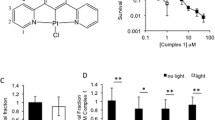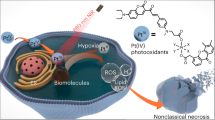Abstract
Metal-based compounds have been used to treat cancer for decades, with cisplatin being the most common and widely used. Photodynamic therapy (PDT) is another clinical modality used to fight cancer, which uses a photosensitizer (PS) that localizes in cancer tissues. This PS is activated by the illumination of the tumor with visible light. Photoactivated chemotherapy (PACT) is a new concept that brings these two ideas together. Like PDT , PACT aims at sparing healthy tissues while maintaining toxicity against cancerous cells. Unlike PDT , which often stops working when the concentration of dioxygen in illuminated tissues is too low, light activation of PACT compounds remains efficient in hypoxic cancer cells. This chapter addresses the methodology to experimentally measure the phototoxicity of PACT compounds in cancer cell lines, under both normoxic and hypoxic conditions.
Access this chapter
Tax calculation will be finalised at checkout
Purchases are for personal use only
Similar content being viewed by others
References
Eljack ND, Ma H-YM, Drucker J et al (2014) Mechanisms of cell uptake and toxicity of the anticancer drug cisplatin. Metallomics 6:2126–2133. https://doi.org/10.1039/C4MT00238E
Jamieson ER, Lippard SJ (1999) Structure, recognition, and processing of cisplatin−DNA adducts. Chem Rev 99:2467–2498. https://doi.org/10.1021/cr980421n
Orvig C, Abrams M (1999) Medicinal inorganic chemistry: introduction. Chem Rev 99:2201–2203
Oun R, Moussa YE, Wheate NJ (2018) The side effects of platinum-based chemotherapy drugs: a review for chemists. Dalton Trans 47:6645–6653. https://doi.org/10.1039/C8DT00838H
Frochot C, Mordon S (2019) Update of the situation of clinical photodynamic therapy in Europe in the 2003–2018 period. J Porphyr Phthalocya 23:347–357. https://doi.org/10.1142/S1088424619300027
Agostinis P, Berg K, Cengel KA et al (2011) Photodynamic therapy of cancer: an update. CA Cancer J Clin 61(250–281). https://doi.org/10.3322/caac.20114
Triesscheijn M, Baas P, Schellens JHM, Stewart FA (2006) Photodynamic therapy in oncology. Oncologist 11:1034–1044. https://doi.org/10.1634/theoncologist.11-9-1034
Allison RR, Moghissi K (2013) Photodynamic Therapy (PDT): PDT Mechanisms. Clin Endosc 46:24–26. https://doi.org/10.5946/ce.2013.46.1.24
Eales KL, Hollinshead KER, Tennant DA (2016) Hypoxia and metabolic adaptation of cancer cells. Oncogenesis 5:e190. https://doi.org/10.1038/oncsis.2015.50
Parks SK, Chiche J, Pouysségur J (2013) Disrupting proton dynamics and energy metabolism for cancer therapy. Nat Rev. Cancer 13:611–623. https://doi.org/10.1038/nrc3579
Farrer NJ, Salassa L, Sadler PJ (2009) Photoactivated chemotherapy (PACT): the potential of excited-state d-block metals in medicine. Dalton Trans:10690–10701. https://doi.org/10.1039/b917753a
Bonnet S (2018) Why develop photoactivated chemotherapy? Dalton Trans 47:10330–10343. https://doi.org/10.1039/C8DT01585F
Lameijer LN, Ernst D, Hopkins SL et al (2017) A red-light-activated ruthenium-caged NAMPT inhibitor remains phototoxic in hypoxic cancer cells. Angew Chem Int Edit 113:8247–8246. https://doi.org/10.1002/anie.201703890
van Rixel VHS, Ramu V, Auyeung AB et al (2019) Photo-uncaging of a microtubule-targeted rigidin analogue in hypoxic cancer cells and in a xenograft mouse model. J Am Chem Soc:1–11. https://doi.org/10.1021/jacs.9b07225
Hopkins SLH, Siewert B, Askes SHC et al (2016) In vitro cell irradiation protocol for testing photopharmaceuticals and the effect of blue, green, and red light on human cancer cell lines. Photoch Photobio Sci 15:644–653. https://doi.org/10.1039/C5PP00424A
Vichai V, Kirtikara K (2006) Sulforhodamine B colorimetric assay for cytotoxicity screening. Nat Protoc 1:1112–1116. https://doi.org/10.1038/nprot.2006.179
Author information
Authors and Affiliations
Corresponding author
Editor information
Editors and Affiliations
Rights and permissions
Copyright information
© 2022 Springer Science+Business Media, LLC, part of Springer Nature
About this protocol
Cite this protocol
Ramu, V., Auyeung, A.B., Bonnet, S. (2022). Cytotoxicity of Metal-Based Photoactivated Chemotherapy (PACT) Compounds. In: Broekgaarden, M., Zhang, H., Korbelik, M., Hamblin, M.R., Heger, M. (eds) Photodynamic Therapy. Methods in Molecular Biology, vol 2451. Humana, New York, NY. https://doi.org/10.1007/978-1-0716-2099-1_17
Download citation
DOI: https://doi.org/10.1007/978-1-0716-2099-1_17
Published:
Publisher Name: Humana, New York, NY
Print ISBN: 978-1-0716-2098-4
Online ISBN: 978-1-0716-2099-1
eBook Packages: Springer Protocols




